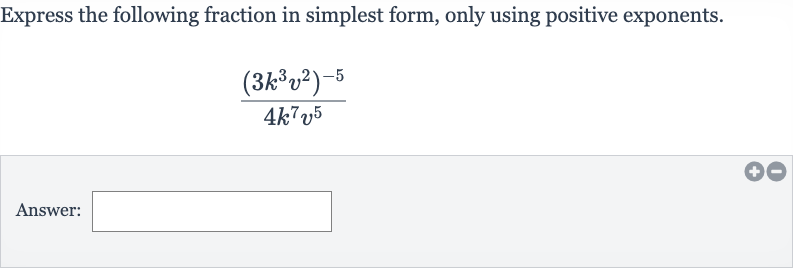AI tutor
Welcome to Bytelearn!
Let’s check out your problem:

Express the following fraction in simplest form, only using positive exponents.Answer:
Full solution
Q. Express the following fraction in simplest form, only using positive exponents.Answer:
- Apply negative exponent rule: Apply the negative exponent rule to the numerator.The negative exponent rule states that . We will apply this rule to the numerator to make the exponent positive.
- Expand numerator exponent: Expand the exponent in the numerator.When raising a power to a power, you multiply the exponents. We will apply this to each factor in the numerator.
- Calculate powers in numerator: Calculate the powers in the numerator.Now we will calculate each of the powers separately.
- Combine numerator and denominator: Combine the numerator and the denominator.Now we will write the entire fraction with the expanded numerator and the original denominator.
- Simplify fraction by dividing: Simplify the fraction by dividing the numerator by the denominator.To divide two fractions, you multiply the first fraction by the reciprocal of the second fraction.
- Multiply the fractions: Multiply the fractions.Now we will multiply the numerators and the denominators separately.
- Combine like terms in denominator: Combine like terms in the denominator.We will add the exponents of like bases in the denominator.
- Calculate exponents and coefficients: Calculate the exponents and coefficients in the denominator.Now we will calculate the exponents and multiply the coefficients.
- Write final answer: Write the final answer with positive exponents.The fraction is already in simplest form with positive exponents.
More problems from Multiplication with rational exponents
QuestionGet tutor help
QuestionGet tutor help
QuestionGet tutor help
QuestionGet tutor help
QuestionGet tutor help
